International Society for Krishna Consciousness
The International Society for Krishna Consciousness (ISKCON), known colloquially as the Hare Krishna movement or Hare Krishnas, is a Gaudiya Vaishnava religious organisation.[1] ISKCON was founded in 1966 in New York City by A. C. Bhaktivedanta Swami Prabhupada.[2] Its core beliefs are based on the Hindu scriptures, particularly the Bhagavad Gita and the Bhagavata Purana, and the Gaudiya Vaishnava tradition, which has had adherents in India since the late 15th century and American and European devotees since the early 1900s.[3]
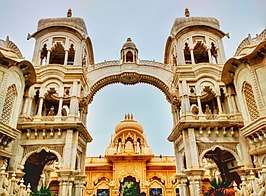 ISKCON Temple in Vrindavan, Uttar Pradesh, India | |
| Abbreviation | ISKCON |
|---|---|
| Motto | Krsnas Tu Bhagavan Svayam |
| Formation | 13 July 1966 New York City, US |
| Founder | A. C. Bhaktivedanta Swami Prabhupada |
| Type | Religious organisation |
| Legal status | Foundation |
| Headquarters | Sri Sri Radha Madhav Panchatattva Temple (ISKCON Mayapur), Mayapur, West Bengal, India |
| Location |
|
| Coordinates | 23.26°N 88.23°E |
Area served | Worldwide |
Main organ | Governing Body Commission |
| Affiliations | Gaudiya Vaishnavism |
| Website | iskcon |
| Part of a series on |
| Vaishnavism |
|---|
 |
|
Holy scriptures
|
|
Sampradayas
|
|
Related traditions |
|
|
The organization was formed to spread the practice of Bhakti yoga, the practice of love of God in which those involved (bhaktas) dedicate their thoughts and actions towards pleasing Krishna, the Supreme Lord.[4] Its most rapid expansions in membership as of 2007 have been within India and especially after the collapse of the Soviet Union, in Russia, Ukraine, and the rest of the ex-Soviet aligned states of Eastern Europe and Central Asia.[5]
Today, it has around a million congregational members worldwide including 15,000 in the United Kingdom as of June 2019,[6] and despite the "relatively small number of followers in the West (around a few thousand fulltime practitioners)", it has been described as influential.[7]
History and belief
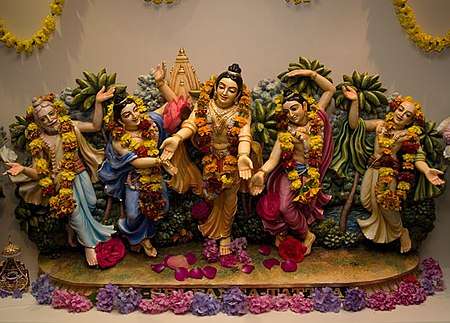
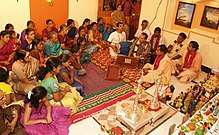
ISKCON devotees follow a disciplic line of Gaudiya Bhagavata Vaishnavas and are the largest branch of Gaudiya Vaishnavism.[8] Vaishnavism means 'worship of Vishnu', and Gauḍa refers to the area where this particular branch of Vaishnavism originated, in the Gauda region of West Bengal. Gaudiya Vaishnavism has had a following in India, especially West Bengal and Odisha, for the past five hundred years. Gaudiya Vaishnavism was founded by the saint Chaitanya Mahaprabhu who rapidly spread his form of ecstatic bhakti (devotion) throughout Bengal. He established Sankirtan, the practice of publicly expressing devotion to Lord Krishna, the Supreme God, through dance and song. This form of communal worship responded to rigid caste structures by engaging all people in worship regardless of caste and creed. Chaitanya emphasized chanting the Hare Krishna Mahamantra (the 'great mantra'). He is considered by Gaudiya Vaishnavas to be an incarnation of Krishna himself.[9][10]
Bhaktivedanta Swami Prabhupada brought Chaitanya's Gaudiya Vaishnavism to the West in 1965. At 69 years old, he landed in New York without any money. Instead of preaching to New York's elite, he tapped into the 1960s countercultural spirit by preaching and chanting in public parks and attracting hippies and the youth. His movement, then known as the "Hare Krishna Movement", grew even larger when he relocated to San Francisco a year later.[10] When it spread to England, it gained publicity and financial backing from the Beatle George Harrison. He recorded several tracks with the Hare Krishnas and included the Mahamantra in his hit track "My Sweet Lord".[11] The first Hare Krishna commune, New Vrindavan (West Virginia), was established by Prabhupada in 1968.[9] Since then, ISKCON has established more than 600 centers all over the world and has millions of followers.[11]
Key to the spread of Gaudiya Vaishnava theology in the Western world was Bhaktivedanta Swami Prabhupada's extensive writings and translations,[12] including the Bhagavad Gita As It Is, Srimad Bhagavatam (Bhagavata Purana), Chaitanya Charitamrita, and other scriptures. These works are now available in more than seventy languages and serve as the scriptures of ISKCON.[13]
ISKCON describes Krishna as the source of all the avatars of God.[14] Thus ISKCON devotees worship Krishna as the highest form of God, svayam bhagavan, and often refer to him as the Supreme Personality of Godhead in writing, which was a phrase coined by Prabhupada in his books on the subject. To devotees, Radha represents Krishna's divine female counterpart, the original spiritual potency, and the embodiment of divine love. The individual soul is an eternal personal identity which does not ultimately merge into a non-dual consciousness (Brahman) as believed by the monistic (Advaita) schools of Hinduism. Prabhupada most frequently offers Sanatana-dharma and Varnashrama dharma as more accurate names for the religious system which accepts Vedic authority.[15] It is a monotheistic tradition which has its roots in the theistic Vedanta traditions.[16]
Practices
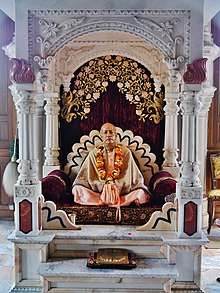

The most famous and publicly recognizable ISKCON practice is kirtan, a congregational chanting or singing of the Hare Krishna mantra. It's both a way to express devotion to God and a way to attract newcomers to the movement. Devotees gather in public, in streets and parks, to sing the mantra accompanied by instruments like the mridanga, hand cymbals, and the harmonium. During the 1970s ISKCON entered the public eye because of this practice. Devotees would sing, distribute books, and proselytize in airports and other public areas, often obtrusively. Sankirtan continues throughout the world today, but in a less confrontational manner.[17]
Other important religious practice within ISKCON and Gaudiya Vaishnavism is japa, or the meditative practice of repeatedly chanting the names of Krishna on a rosary. It's considered the only way for salvation for people in the current age. Prabhupada established a standard for initiated devotees to chant sixteen rounds of the Hare Krishna a day.[18] Each round requires chanting the mahamantra 108 times on prayer beads, with sixteen rounds being 1728 repetitions and taking around two hours.[19]
Another important practice in ISKCON is arati (also called puja). In arati, devotees offer water, incense, a fire lamp, and flowers to a murti, a sacred statue or image of Krishna. This is accompanied by prayers and devotional songs called bhajans. Practitioners may perform aarti at their own home or congregate at a temple to join in the ceremony. Along with this worship, devotees will bathe the murti, dress it, offer it food, and even put it to sleep. By doing arati and serving the murti, devotees aim to deepen their relationship with Krishna.[17]
ISKCON devotees meet regularly (typically on Sunday at a program known as the Sunday Feast)[20] to worship deities, listen to discourses by senior devotees, participate in kirtan and eat sanctified offered food.
Four Regulative Principles
During initiation (diksha) ISKCON devotees vow to follow four basic rules and regulations,[17] They are-
- to follow a lacto-vegetarian diet
- not to consume any intoxicants (alcohol, cigarettes or drugs)
- not to gamble
- not to engage in 'illicit sex'.[19]
Festivals
Besides weekly gatherings, devotees within the ISKCON movement celebrate a diverse array of Hindu festivals, including Janmashtami, Radhashtami, Diwali, Gaura Purnima, Ekadasi, Holi, Rama Navami and Gita Jayanti.[21]
The Ratha Yatra Festival of Chariots is an annual parade whereby devotees chant and dance on the street, pulling a chariot with the deities of Lord Jagannatha, Baladeva, and Subhadra behind them. This public procession is typically followed by performances and free vegetarian food.[22]
Preaching
ISKCON advocates preaching.[23] Members try to spread Krishna consciousness primarily by singing the Hare Krishna mantra in public places and by selling books written by the founder.[24]
A study conducted by E. Burke Rochford Jr. at the University of California found that there are four types of contact between those in ISKCON and prospective members. Those are individually motivated contact, contact made with members in public areas, contact made through personal connections, and contact with sympathizers of the movement who strongly encourage people to join.[25]
According to the doctrine of Chaitanya Mahaprabhu, one does not need to be born in a Hindu family to take up the practice. There are ISKCON communities around the world with schools, restaurants, and farms.
Centres worldwide
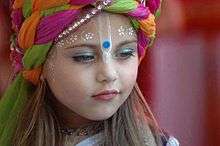
India
India has the highest density of ISKCON centres in the world, with over 150 temples, 12 state-recognized educational institutions, 25 affiliated and non-affiliated restaurants, and a number of tourist and pilgrimage hotels.[26] It is also home to Govardhan Eco-Village, an ayurvedic treatment and retreat centre near Mumbai.[27] ISKCON India has been known to espouse more traditional orthodox Vedic values than its Western counterparts.[28]
Shri Mayapur Chandroya Mandir Temple of the Vedic Planetarium, Mayapur
Set to be completed in 2022, the Sri Mayapur Chandroya Mandir in West Bengal is built in the birthplace of Sri Chaitanya Mahaprabhu, the founder of the Gaudiya-Vaishnava lineage of Hinduism. The temple itself currently sits at 425 000 square feet and is 340 feet tall, and is surrounded by accompanying lodges, shops, residences, educational centres, and gardens. The project cost an estimated $75 million, with its’ major investor being Alfred B. Ford, the great-grandson of Henry Ford. The complex ‘s main attraction is a planetarium based on Vedic cosmology as well as exhibitions about the Vedic arts, sciences and culture as described in the Srimad Bhagvatam. After completion, the temple will be the biggest in the world, second to Angkor Wat in Cambodia.[29]
Sri Sri Krishna Balarama Mandir, Vrindavan
Located in the Raman Reti area of Vrindavan, Uttar Pradesh, the temple was built in the original village where the spiritual figures Krishna and Balarama are said to have resided in the Vedic period of Indian history. It is built in close proximity to other holy sites such as the village of Gokul, Govardhana Hill, the Mathura palace, and various holy lakes. As a result, ISKCON Vrindavan is a common pilgrimage site for followers of the Krishna Conscious movement. The complex is home to a guesthouse, a museum, gift shops, a restaurant, a bakery, a broadcast studio as well as a marble temple hall.[30] The temple is also affiliated with the Vrindavan Institute of Higher Education.[31]
Vrindavan Chandrodaya Mandir, Bangalore
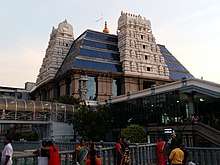
Overseen by ISKCON Bangalore, the VCM is currently under construction and slated to be the tallest religious monument in the world, featuring a helipad, theme park, museum, accommodation, wooded and park area and temple.[32]
Sri Sri Parthasarathi Mandir, New Delhi
The temple complex houses the Glory of India Vedic Cultural Centre which is a set of interactive educational exhibits, as well as the world’s largest printed religious book, known as the “Astounding Bhagavad Gita”.[33]
Sri Sri Radha Madhav Sundar Mandir, Siliguri
This temple is located at Siliguri[34] and known as Gupta Nabadweep Dham.
Europe
There are over 135 ISKCON-affiliated temples and cultural centres in Europe. The ISKCON movement in Europe is home to a number of rural and farming communities, including Nueva Vrajamandala in Spain,[35] La Nouvelle Mayapura[36] in France and Villa Vrindavan[37] in Italy.
Radhadesh, Belgium
The Radhadesh temple in Durbuy, Belgium is home to Bhaktivedanta College, which opened in 2002 to provide ministerial and spiritual education for students, offering degrees and certificates online and on campus in Vaishnava theology externally validated by the University of Chester.[38]
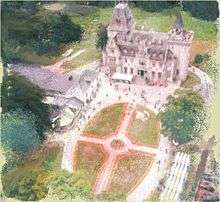
The Radhadesh temple is also home to Radhadesh Mellows, an annual kirtan retreat.[39]
Bhaktivedanta Manor, Watford
A landscaped property featuring gardens, lakes, a school, farm, numerous temple and housing buildings, accommodations and a bakery, the property for Bhaktivedanta Manor was donated by George Harrison of the Beatles and is on the National Heritage List for England. The houses on the property, including the temple, are built in the mock-Tudor mansion style of the 1800s.[40]
Bhaktivedanta Manor is also home to the London College of Vedic Studies,[41] and is the birthplace of the Avanti Schools Trust, a sponsor of state-funded primary and secondary schools that provides both non-denominational and Hindu-faith education throughout the UK.[42]
Demographically, devotees in Europe are majority ethnic Europeans. An exception can be made with the demographics of devotees in the United Kingdom, which caters to the Indian immigrant population, mirroring the demographics of most North American centres.[43]
North and South America
There are 56 formally affiliated ISKCON centres in the United States.[44] Notable centres include New Raman Reti in Alachua, FL[45] and The Radha Kalachandji Temple in Dallas, TX.[46] Hare Krishna-affiliated full-time communities include New Vrindaban in West Virginia,[47] and Gita Nagari Eco Farm and Sanctuary in Pennsylvania.[48] There are various other centres in the United States that promote Krishna Conscious culture without being formally affiliated with ISKCON, including The Bhakti Center in New York City.[49] The ISKCON Dallas temple is affiliated with the nearby TKG Academy,[50] which provides private school academic education with additional Vedic-based courses.
There are 12 ISKCON centres in Canada, including the self-sustaining Saranagati Eco Village in BC.[51] There are 5 formally affiliated ISKCON centres in Mexico.
There are 60 affiliated ISKCON temples in South America, with most congregations located in Argentina and Brazil. There are also a number of devotee-run farming communities throughout Latin America.[52]
Asia, Africa and Australasia
Asia is home to over 80 ISKCON affiliated centres, with most being located in Indonesia, Malaysia, and the Philippines.[53] There are 31 additional centres in Russia, as Vaishnava Hinduism represents one of the largest denominations of faith in the country.[54]
There are 69 affiliated ISKCON centres in Africa, four of which are rural farming communities and three of which are educational centres.[55] ISKCON Durban hosts the world's largest Ratha Yatra Chariot Festival outside of India.[56]
There are six ISKCON centres including one farming village in Australia and four temple centres in New Zealand.[57] The Hare Krishna Temple in Christchurch, New Zealand, distributed free meals to mourners and the local Muslim community after a mosque shooting in March 2019.[58]
Kirtan and music influence
The practice of mantra meditation, also known as kirtan, is prominent in the ISKCON movement. Dedicated kirtan festivals are held annually around the world, such as the Sadhu Sanga Retreat in Boone, North Carolina,[59] Kirtan 50[60] in Dallas, Texas, and Radhadesh Mellows, in Durbuy, Belgium. Notable kirtaneers include Jahnavi Harrison, Gaura Vani, and the Mayapuris,[61] who have all released kirtan albums. Kirtan sessions are also held outside of temple settings, including at local university “Bhakti Clubs”, mantra lounges, and at yoga and wellness festivals.[62]
Full theatrical performances have been produced based on the Vedic mythologies. Prominent performance companies include Viva Kultura[63] and Vande Arts.[64]
Vegetarianism
Vegetarianism is one of the four tenets of ISKCON.[19]
With respect to AC Bhaktivedanta Swami Prabhupada's focus on food distribution,[65] many ISKCON devotees have opened vegan and vegetarian eateries based on the Vedic non-violent eating principles. These include the informal “Govindas’” food chain,[66] Doughnut Plant,[67] Divya’s Kitchen NYC[68] and OmNom Enlightened Eating.[69]
Not all restaurants opened by ISKCON members are officially affiliated with ISKCON, although many Govindas’ restaurants or catering businesses operate out of the main temple center.
Charitable projects
Cow Protection and ISCOWP
ISCOWP (International Society for Cow Protection) was designed to “present alternatives to agricultural and dietary practices that support and depend upon the meat and dairy industries’ slaughter of innocent animals, specifically the cow”. Their philosophy of “compassionate cow protection” stems from the Hindu Vedic value of ahimsa, or non-violence, and the deity Krishna's affection for cows and butter. ISCOWP believes that “the tenets of cow protection are universal and non-sectarian, available to all regardless of race, creed, or nationality”.[70]
ISKCON has a number of cow protection farms and centres known as “goshalas” around the world in farming communities and temples. In 2018, Gita Nagari Eco Farm and Sanctuary was the only USDA-Certified slaughter-free dairy production facility in the United States.[71]
ISKCON Tribal Care Trust
ISKCON Tribal Care Trust (ITCT) is an ISKCON affiliate which aims at providing socio-economic development to the tribal people. The trust has set up schools and potable water sources for the tribal people[72] They also distribute blankets and study materials to the tribal communities.[73]
Food For Life Global

Managed by ISKCON devotees but ultimately unaffiliated with the ISKCON movement, Food For Life Global is a not-for-profit vegan food relief organization with 211 international affiliates. The organization predicts Food for Life volunteers distribute 2,000,000 free meals daily through outreach to the homeless, school lunch programs, orphanages and for victims of natural disasters. Notable missions include food distribution during the Chechen Wars[74] and during the aftermath of Hurricane Katrina.[75]
There is internal debate as to whether food distribution efforts should be required to include religious preaching, prayer or book distribution, but as of 2020 this is not mandated by the organization.[76] However, food distributed in these missions, as per customs of the ISKCON movement, is often offered to temple deities prior to distribution.
Management structure
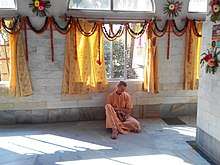
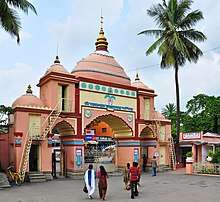
Bhaktivedanta Swami spent much of the last decade of his life setting up the institution of ISKCON.[77][78]
The Governing Body Commission (or GBC) was created by him in 1970.[79] In a document Direction of Management written on 28 July 1970 Prabhupada appointed twelve members to the commission, all of them non-sannyasi, including Satsvarupa dasa Goswami, Hansadutta Swami, and Tamala Krishna Goswami.[77] The letter outlined the purposes of the commission: improving the standard of temple management, the spread of Krishna consciousness, the distribution of books and literature, the opening of new centers and the education of the devotees. GBC has since grown in size to include 48 senior members from the movement who make decisions based on consensus of opinion.[77][80]
Succession of teachings
ISKCON's founder A. C. Bhaktivedanta Swami Prabhupada claimed to belong to the traditional system of paramparā, or disciplic succession, in which teachings upheld by scriptures are handed down from master to disciple, generation after generation.
Specialty programming
Youth Ministry
Most ISKCON temples offer Sunday School services for children of devotees during the weekly program. The curriculum of these classes may vary by location.
ISKCON Pandava Sena
Based out of Bhaktivedanta Manor of Watford UK, ISKCON Pandava Sena is a youth organization that aims to “connect like-minded souls to the timeless philosophy of the Vedas”. The organization started in 1994 and is now composed of a variety of professionals and university students that host annual international mentorship and reunion retreats and weekly social gatherings.[81]
Pandava Sena has also established “KCSocs” or “Krishna Conscious Societies” across 30 universities in the UK, bringing spirituality-based programming to students and working professionals. Many universities have similar student groups featuring youth from local ISKCON temples congregating for yoga, vegan food, or mantra meditation based on the KCSoc model.[82]
The Sanga Initiative is a similar organization that is based in the United States and hosts an annual youth retreat and camping trip for ISKCON children called Camp Ignite.[83]
Youth Bus Tour
Also known as the Krishna Culture Festival Tours, these tours occur multiple times a year and invite students and young professionals in the bhakti tradition to take cultural performances and services to various locations, including Puerto Rico, the Caribbean, Mexico, Australia, China, Scandinavia, and Canada. There are various age and gender-specific groups available for tour participation.[84]
ISKCON Vaishnavi Ministry
Women's roles are a controversial issue within ISKCON, and its members have strongly divergent opinions regarding the interpretation of Srila Prabhupada's teachings on gender roles.[85] While some of its leaders advocate that women should take public leadership roles,[86] other leaders disagree, and maintain that "traditional" roles for women are more appropriate. They fear an undesirable influence of secular feminism within ISKCON.[87]
According to the essay "Women in ISKCON in Prabhupada's times" written by Jyotirmayi Devi Dasi, women are renowned within ISKCON and regarded as completely equal in regards to spirituality.[88] Prabhupada in his original writings encouraged the complete equality of women in the eye of Krishna based on the teachings of Bhagavad Gita that soul does not have any gender and everybody is eligible for spiritual liberation.[89][90]
Since mother is the most respected position in Vedic culture, women within the Hare Krishna community are all viewed as mothers, especially by celibate male members brahmacharis. "Mother is a term of respect for women in the International Society for Krishna Consciousness (ISKCON), and is often prefixed to the Sanskrit name they receive in initiation. Even unmarried women are referred to as mothers".[91]
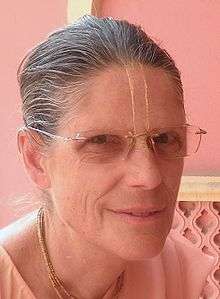
After years of discussion and reforms, a general consensus emerged to accept women as leaders and initiators in ISKCON. In 1998 Malati Devi Dasi became the first woman appointed to the GBC.[92] The second woman leader, Dina Sharana, was selected in 2009.[93]
An updated document was released by the GBC in 2019 stating that it was permissible for women to become initiating gurus within the ISKCON movement.[94]
The Ministry was developed to account for the growing interest of female devotees to partake in temple practices and ensure representation in decision making.
ISKCON Child Protection Office
A suit for $900 million was filed in Texas State Court by alleged victims of abuse in the temples' schools in the 1970s and 1980s.[95][96] ISKCON had to later file for Chapter 11 bankruptcy protection.[97] Known as the Turley Case, the eventual 2008 settlement was $15 million.[98]
In 1998, ISKCON published an exposé of widespread physical, emotional and sexual abuse of children in the group's boarding schools in the United States and India. The Hare Krishna monks and young devotees caring for the children had no training in the task and often resented having to perform it, the report said. At a meeting in 1996, former Krishna pupils testified that they had been regularly beaten at school, denied medical care, and sexually molested and raped.[96]
The ISKCON Central Office of Child Protection was established by the GBC in 1997, and in 2005, released its first official Child Protection Policy and Procedure Guidelines. The CPO has provided Child Protection Information Training to over 500 child care providers within the organization internationally and continues to file and review reports on local Child Protection Teams. The Child Protection Policy and Procedure Guidelines was revised and ratified by the GBC in June 2018.[99]
Significant Organizations
- The Grihastha Vision Team provides premarital, parenting and family counselling services to members of any Vaishnava community. The team is made up of volunteers who are mental health and/or educational professionals outside of the religious community.[100]
- The Bhaktivedanta Medical Associations’ mission is to ”connect and inspire all devotees within the medical profession; to improve our practice of Krishna consciousness; to assist one another to improve our service to Srila Prabhupada: and the expand Krishna consciousness among medical professionals.”[101] Based in the US, the BMA hosts an annual medical conference for physicians and medical students with accredited North American hospitals and medical schools. Areas of interest include ayurvedic and natural health, mental health, physician burnout, meditation research, and dietary research.[102]
- Started in 2002, ISKCON Resolve is a “neutral, confidential and informal” conflict-resolution service for ISKCON congregation members and leaders. Services provided include ombudsman services, conflict mediation services, and self-help tools.[103]
- The ISKCON Domestic Abuse Coalition's mission is "to raise awareness of [domestic abuse] within ISKCON and provide valuable resources for victims, leadership and the community at large." The group formed in 2019 to release a statement denouncing all forms of domestic violence and mistreatment of women within the ISKCON movement.[104]
Relationship with other Religions
ISKCON has a friendly relationship with other Religious societies seeing them as contributing in inculcating spiritual values in people.
In a historic first, ISKCON brought together the four Vaishnava Sampradayas for a Sankirtan festival in the year 2015.[105]
It also has been organizing Vaishnava-Christian dialogues in the West for over 30 years to explore common ground between the two personalistic faiths.[106] In India they have been organized from 2015 onwards.[107]
Controversies
ISKCON has experienced a number of significant internal problems, the majority of which occurred from the late seventies onwards, and especially within the decade following Prabhupada's death.[108] ISKCON has also been scrutinised by some anti-cult movements.[109][110]
- In a landmark 1976 case, People vs. Murphy, the Supreme Court of New York found that "'the Hare Krishna religion is a bona fide religion with roots in India that go back thousands of years." Although the parents of two Hare Krishna members claimed ISKCON had brainwashed their children, the court found they had not and that their children had freely followed the tenets of their chosen faith.[111][112]
- A brainwashing lawsuit filed by an Orange County mother and daughter, Robin George, in 1977 led to numerous appeals reaching the Supreme Court. In a long-awaited ruling on religious liberty, the state appeals court dismissed a claim that the Hare Krishna sect brainwashed a 15-year-old girl. In addition to the brainwashing claim, the 4th District Court of Appeal dismissed claims that they intentionally caused Robin George emotional distress and libeled her.[113]
- Kirtanananda Swami, or Swami Bhaktipada, a leader of ISKCON, was expelled from the organisation in 1987 for various deviations;[114] he pleaded guilty before his 1996 retrial to one count of racketeering and after serving 8 years of a 20-year prison sentence was subsequently released in 2004. Previously in 1991 the jury found him not guilty on charges of conspiracy to commit the murders-for-hire of two devotees, but found him guilty of racketeering and mail fraud. These convictions were later overturned on appeal, only to result in the later retrial.[115][116][117] Kirtanananda is no longer considered a bonafide ISKCON initiating guru by the movement. The case placed a spotlight on New Vrindaban, which by then had nearly 500 members, making it the largest and most famous Hare Krishna community in the United States at that time.[118]
- In the 1990s ISKCON faced accusations of child abuse, and its leaders acknowledged physical, emotional and sexual abuse of children who were sent to live in the movement's boarding schools in the United States and India in the 1970s and 1980s.[119][120] Several safety regulations and subcommittees, such as ISKCON Resolve and the ISKCON Child Protection Office, have been developed since these allegations to ensure that legal rights as well as the health and safety of devotees are protected.
ISKCON is banned in Singapore.[121] It has also been called for banning in Bangladesh by the Hefazat-e-Islam organisation.[122]
Persecution
- From 1971-1989, ISKCON devotees were jailed and beaten for performing their faith in public by the KGB. Details of the struggle of devotees to maintain their religious practices amidst Soviet policies have been fictionalized in the play "A Taste of Salted Bread".[123]
- In 2006, a bomb blast occurred in the Iskcon Imphal in Manipur. In the bomb blast 5 devotees died and a further 50 were injured.[124][125]
- In 2007, the Kazakhstan government authorities demolished 25 homes belonging to the ISKCON members in Sri Vrindavan Dham commune in Almaty, on the grounds that they were illegal constructions.[126]
- In 2009, an orphanage run by the ISKCON Chittagong (Sri Sri Radha Madhava Mandir) in Bangladesh was attacked by unknown men. The gang vandalised furniture and a statue in the orphanage and beat the devotees. They also tried to take control of the temple and the orphanage.[127]
- In 2015, the ISKCON Dinajpur in Bangladesh was attacked by Jama'atul Mujahideen of Bangladesh terrorists.The terrorists opened fire and at least two people were injured in the attack.[128][129]
- In 2016, the Iskcon Sylhet in Bangladesh was attacked by Muslims and at least ten people were injured in that attack.[130][131]
- In 2018, the gate of the ISKCON Temple in Curitiba, Brazil was targeted by unknown perpetrators. The painting of Krishna with his mother Yashoda was defaced.[132]
- In 2018, Rath yatra organised by ISKCON Dhaka in Bangladesh was attacked by a group of people, leaving six devotees injured.[133]
- In 2020, the banned terrorist organisation Ansar al-Islam planned an attack on the ISKCON Dhaka but police arrested them.[134]
In popular culture
The Hare Krishna mantra appears in some famous songs, such as former Beatle George Harrison's 1970 hit "My Sweet Lord".[135][136] John Lennon included the phrase "Hare Krishna" in his lyrics to "Give Peace a Chance" and the Beatles' 1967 track "I Am the Walrus". The backing vocalists also sing the phrase in Ringo Starr's 1971 hit "It Don't Come Easy", written with the help of Harrison, although the words were mixed low on the released version.[137]
Of the four Beatles, only Harrison fully embraced Krishna Consciousness. He also provided financial support for ISKCON's UK branch and in 1973 purchased Bhaktivedanta Manor as their training centre.[138] Harrison enjoyed a warm friendship with Swami Prabhupada,[139][140] who provided the inspiration for Harrison songs such as "Living in the Material World".[141]
Other influencers with roots in ISKCON include:
See also
References
- Gibson 2002, p. 4
- Gibson 2002, p. 6
- Bharati, Baba Premanand Archived 1 October 2017 at the Wayback Machine. Hinduism.enacademic.com. Retrieved on 2013-07-26.
- Beck 2005, p. 39, "According to Orthodox Gaudiya. Krishna's svarupa, or true form manifests in three ways. His svayam-rupa or transcendent form is self-existent, not dependent on anything. His tadekatma rupa is identical in essence to his true form, though it differs in appearance (and would include such forms of Krishna as Narayana and Vasudeva). His avesa form has Krishna appearing though in varying degrees of possession"
- Cole & Dwyer 2007, p. 38
- Profile of ISKOC on Religion Media Centre
- Malory Nye, Religion: The Basics, Routledge, 2008, chapter 2
- Bryant & Ekstrand 2004, p. 34
- "Hare Krishna". ReligionFacts. Retrieved 24 June 2019.
- "Influences". www.patheos.com. Retrieved 24 June 2019.
- Desai, Ronak D. "ISKCON Celebrates 50 Years Since Its Founding". Forbes. Retrieved 25 June 2019.
- A Hinduism, Page 8, Lynne Gibson, 2002
- "Bhaktivedanta Vedabase Online".
- Gibson 2002, p. 18
- Brzezinski, J. "Vol 6, No 2 December 1998 ICJ". www.iskcon.com. Archived from the original on 29 June 2013.
- Laderman, Gary (2003). "ISKCON". Religion and American Cultures: An Encyclopedia of Traditions, Diversity, and Popular Expressions. Santa Barbara, Calif: ABC-CLIO. ISBN 1-57607-238-X.
- "Rites and Ceremonies". www.patheos.com. Retrieved 3 August 2019.
- Hüsken, Ute, and Christiane Brosius, eds. Ritual matters: dynamic dimensions in practice. Routledge, 2010.
- Bryant, Edwin Francis. Ekstrand, Maria. (2004). The Hare Krishna movement the postcharismatic fate of a religious transplant. Columbia University Press. OCLC 748865897.CS1 maint: multiple names: authors list (link)
- "The Hare Krishna Temple Sunday Feast". Back to Godhead. 31 October 2019. Retrieved 4 January 2020.
- "Festivals » Home – ISKCON – The Hare Krishna Movement". Retrieved 4 January 2020.
- "Ratha-yatra, The Festival of Chariots | Krishna.com". www.krishna.com. Retrieved 4 January 2020.
- ISKON LAWBOOK, Section 4.3, International Society For Krishna Consciousness, http://krishna.ie/images/docs/2009-10-19-IskconLawBook.pdf, Publication October 19, 2009
- Krishna Consciousness in the West – David G. Bromley, Prof. Larry D. Shinn, 1989, Page 149
- Rochford, E Burke, Jr.Recruitment Strategies, Ideology, and Organization in the Hare Krishna Movement Social Problems Vol.29, No 4 1982
- "India | ISKCON Centers". Retrieved 4 January 2020.
- "Wellness Retreat in Mumbai | Eco Resorts - Govardhan Ecovillage". www.ecovillage.org.in. Retrieved 4 January 2020.
- Blumetti, Jordan (4 June 2019). "'It's latent misogyny': Hare Krishnas divided over whether to allow female gurus". The Guardian. ISSN 0261-3077. Retrieved 4 January 2020.
- "Temple of the Vedic Planetarium - Home". Temple of the Vedic Planetarium. Retrieved 4 January 2020.
- "ISKCON Vrindavan - Home". ISKCON Vrindavan. Retrieved 4 January 2020.
- "Welcome to Vrindavan Institute for Higher Education". vihe.org. Retrieved 4 January 2020.
- "Vrindavan Chandrodaya Mandir | The Tallest Temple in India - VCM". www.vcm.org.in. Retrieved 4 January 2020.
- "Home". www.iskcondelhi.com. Retrieved 4 January 2020.
- "Siliguri ward no 40". Info Data India.
- "The Glories of Nueva Vraja Mandala, Spain". ISKCON News. Retrieved 4 January 2020.
- "La Nouvelle Mayapur, Iskcon New Mayapur - Luçay-le-Mâle - Hindu Temple, Religious Center | Facebook". www.facebook.com. Retrieved 4 January 2020.
- "Villa Vrindavana". Retrieved 4 January 2020.
- "Bhaktivedanta College". Bhaktivedanta College. Retrieved 4 January 2020.
- "Home". Radhadesh Mellows. Retrieved 4 January 2020.
- "Bhaktivedanta Manor – Hare Krishna Temple". Retrieved 4 January 2020.
- "New Home Page". The College of Vedic Studies. Retrieved 4 January 2020.
- mayapur. "Home". Avanti Schools Trust. Retrieved 4 January 2020.
- "Checkmate: ISKCON's Victory in Russia | Back to Godhead". btg.krishna.com. Retrieved 4 January 2020.
- "United States Of America | ISKCON Centers". Retrieved 4 January 2020.
- "Home". Alachua Hare Krishna Temple. Retrieved 4 January 2020.
- Bhisma. "Home". Radha Kalachandji Temple. Retrieved 4 January 2020.
- "New Vrindaban – The Land of Krishna". newvrindaban.com. Retrieved 4 January 2020.
- "Home - Gita Nagari Eco Farm & Sanctuary". Gita Nagari Eco Farm & Sanctuary. Retrieved 4 January 2020.
- "bhakticenter.org". Retrieved 4 January 2020.
- "TKG Academy | TKG Academy | Dallas' Only Vegetarian Friendly Private School". Retrieved 4 January 2020.
- "Home | Saranagati Community Network". saranagati.ca. Retrieved 4 January 2020.
- "Latin America | ISKCON Centers". Retrieved 4 January 2020.
- "Asia | ISKCON Centers". Retrieved 4 January 2020.
- "Russia | ISKCON Centers". Retrieved 4 January 2020.
- "Africa – ISKCON Centres". Retrieved 4 January 2020.
- "PressReader.com - Your favorite newspapers and magazines". www.pressreader.com. Retrieved 4 January 2020.
- "ISKCON New Govardhana Australia Home". ISKCON New Govardhana Australia. Retrieved 4 January 2020.
- "Kalasamvara Das". www.facebook.com. Retrieved 4 January 2020.
- "Sadhu Sanga Retreat – Sadhu Sanga Retreat organized in the USA by Indradyumna Swami". Retrieved 4 January 2020.
- "Kirtan50 – Dallas New Year Kirtan Festival". Retrieved 4 January 2020.
- kishrico. "Home". The Mayapuris. Retrieved 4 January 2020.
- "Mantra Lounge". Kirtan London - Official Website. Retrieved 4 January 2020.
- Srinam. "Viva Kultura Home". Viva Kultura. Retrieved 4 January 2020.
- "VANDE Supports Vaishnava Arts and Culture in ISKCON". ISKCON News. Retrieved 4 January 2020.
- "Prabhupada". Food for Life Global. Retrieved 4 January 2020.
- "Govinda's". www.ottawa.iskcon.ca. Retrieved 4 January 2020.
- "New Yorkers Go Dough Nuts for Prasadam". ISKCON News. Retrieved 4 January 2020.
- "Home | Divya's Kitchen | Vegetarian Ayurvedic Restaurant | NYC". Divya's Kitchen. Retrieved 4 January 2020.
- "OMNOM London - Enlightened Eating and Yoga Studio". OmNom. Retrieved 4 January 2020.
- "ISCOWP – The International Society of Cow Protection". iscowp.org. Retrieved 4 January 2020.
- "Slaughter-free milk is great for cows, but not the environment". Grist. 22 July 2014. Retrieved 4 January 2020.
- "Tripura Minister praises ISKCON's India Tribal Care Trust". Uniindia. TNN. 18 March 2018. Retrieved 22 February 2020.
- "Blankets and study materials distributed in tea plantation by ISKCON Tribal Care".
- New York Times, December 12, 1995 Archived 16 June 2006 at the Wayback Machine
- "Food for Life Global". Food for Life Global. Retrieved 4 January 2020.
- "Undiluted Iskcon: Food For Life is a deviation". Undiluted Iskcon. Retrieved 4 January 2020.
- Das Goswami, S. (1982). Srila Prabhupada-lilamrta, Vol 4: In Every Town and Village, Around the World, 1968–1971. Los Angeles: Bhaktivedanta Book Trust. ISBN 978-0892131150.CS1 maint: ref=harv (link)
- Knot, Kim "Insider and Outsider Perceptions of Prabhupada" in ISKCON Communications Journal Vol. 5, No 1, June 1997: "In an evaluation of the nature of the guru, Larry Shinn, a scholar of religions, utilised Max Weber's analysis of charisma in order to understand Prabhupada and the issue of leadership in ISKCON. He noted that 'Prabhupada profited from two intertwined sources of authority' (1987:40), the traditional authority of the disciplic lineage, parampara, inherited from his own guru, and his own charismatic authority, derived from his spiritual attainment and presence ... (49) Shinn offered an analysis based on sociological rather than spiritual (Vaishnava) authority in order to make sense of the role of guru in ISKCON and the unique qualities of Prabhupada." See also Larry D. Shinn (1987), The Dark Lord: Cult Images and the Hare Krishnas in America. Philadelphia: The Westview Press.available online
- Cole & Dwyer 2007, pp. 181–183; 30: "Out of some of his most committed disciples, Srila Prabhupada created ISKCON's international Governing Body Commission (GBC)"
- Maria Ekstrand; Bryant, Edwin H. (2004). The Hare Krishna movement: the postcharismatic fate of a religious transplant. New York: Columbia University Press. p. 205. ISBN 0-231-12256-X.A.C. Bhaktivedanta Swami Prabhupada. Letter of 28 July 1970. "As we have increased our volume of activities, now I think a Governing Body Commission (hereinafter referred to as the G.B.C.) should be established. I am getting old, 75 years old, therefore at any time I may be out of the scene, therefore I think it is necessary to give instruction to my disciples how they shall manage the whole institution. They are already managing individual centers represented by one president, one secretary and one treasurer, and in my opinion they are doing nice. But we want still more improvement in the standard of Temple management, propaganda for Krishna consciousness, distribution of books and literatures, opening of new centers and educating devotees to the right standard."
- "About". ISKCON Pandava Sena. Retrieved 4 January 2020.
- Dwyer, Graham; Cole, Richard J. (March 2013). Hare Krishna in the Modern World. Arktos. ISBN 978-1-907166-47-1.
- "The Sanga Initiative". The Sanga Initiative. Retrieved 4 January 2020.
- "Youth Bus Tours". Youth Bus Tours. Retrieved 4 January 2020.
- Rochford Jr., E. Burke. Hare Krishna Transformed. New York University Press.
- Dasa Goswami, Hridayananda. "Role of Women".
- Swami, Bhakti Vikasa. "Feminist Rhetoric on Dandavats".
- "Women in ISKCON in Prabhupada's Times by Jyotirmayi Devi Dasi Reposted November 29, 2002".
- "Bhaktivedanta Vedabase Online".
- "Bhaktivedanta Vedabase Online".
- Palmer, Susan (1994). Moon Sisters, Krishna Mothers, Rajneesh Lovers: Women's Role in New Religions. Syracuse, New York: Syracuse University Press. pp. 15, 17. ISBN 978-0-8156-0297-2.
- Rochford (2007) p. 148 NYU Press
- "Women in ISKCON Archived 29 June 2013 at Archive.today" by Visakha Dasi and Sudharma Dasi
- "GBC Approves Vaishnavi Diksa Gurus in ISKCON". ISKCON News. Retrieved 4 January 2020.
- "BBC News - AMERICAS - Krishnas to file for bankruptcy". bbc.co.uk.
- Goodstein, Laurie (9 October 1998). "Hare Krishna Movement Details Past Abuse at Its Boarding Schools". The New York Times.
- "Hare Krishnas Say Suit Spurs Bankruptcy Filing". latimes. Archived from the original on 6 March 2016. Retrieved 22 July 2018.
- "Children of ISKCON vs. ISKCON Timeline". Surrealist.org. Archived from the original on 9 February 2018. Retrieved 22 July 2018.
- "ISKCON Child Protection Office". childprotectionoffice.org. Archived from the original on 24 August 2017. Retrieved 22 July 2018.
- "Vaisnava Family Resources". Vaisnava Family Resources. Retrieved 4 January 2020.
- "Bhaktivedanta Medical Association". www.facebook.com. Retrieved 4 January 2020.
- iskconhouston.org https://iskconhouston.org/events/bmahouston2020/. Retrieved 4 January 2020. Missing or empty
|title=(help) - "ISKCON Resolve". ISKCON Resolve. Retrieved 4 January 2020.
- "Iskcon Domestic Abuse Coalition". www.facebook.com. Retrieved 8 January 2020.
- "Four Vaishnava Sampradayas Will Join ISKCON to Chant For Change". Retrieved 27 May 2020.
- "Vaishnava-Christian Dialogues". Retrieved 27 May 2020.
- "Vaishnava-Christian Dialogues in India". Retrieved 27 May 2020.
- "Hare Krishna! iskcon.com is your official guide to the International Society For Krishna Consciousness". iskcon.com. Archived from the original on 11 February 2011. Retrieved 22 July 2018.
- Knott, K. (2000). "In Every Town and Village: Adaptive Strategies in the Communication of Krishna Consciousness in the UK, the First Thirty Years". Social Compass. 47 (2): 153. doi:10.1177/003776800047002002.CS1 maint: ref=harv (link)
- Larry Shinn. "The Maturation of the Hare Krishnas in America". Archived from the original on 3 January 2013. Retrieved 18 April 2008. Cite journal requires
|journal=(help)CS1 maint: ref=harv (link) - "People vs. Murphy". The Leagle. 16 March 1977.
- "Judge Rejects Charges of Brainwashing against Hare Krishna Leaders". New York Times. 18 March 1977.
- "Krishnas Did Not Brainwash Girl, Court Rules". Los Angeles Times. 31 August 1989. Archived from the original on 31 May 2017.
- "Krishna Expels Leader of Group Under U.S. Probe". latimes. Archived from the original on 10 September 2016. Retrieved 22 July 2018.
- Fox, Margalit (24 October 2011). "Swami Bhaktipada, Ex-Hare Krishna Leader, Dies at 74" – via NYTimes.com.
- "Disgraced former leader of US Hare Krishna community dies at 74". Telegraph.co.uk. 26 October 2011.
- "Kirtanananda Swami: US Hare Krishna leader, deposed after a racketeering conviction". The Independent.
- "Can Hare Krishnas at Palace of Gold in W.Va. rebuild its tarnished community?". Washington Post.
- "Sex abuse case could ruin Hare Krishnas". The Independent. 14 June 2000. Retrieved 16 February 2019.
- Goodstein, Laurie (9 October 1998). "Hare Krishna Movement Details Past Abuse at Its Boarding Schools". The New York Times.
- "Once in the shadows, Hare Krishnas now seek to shake off the past". City: Singapore. Chanelnewsasia. TNN. 2 August 2017. Retrieved 9 January 2020.
- "Bhola clash: Hefazat holds protest rally in front of Baitul Mukarram mosque". Dhaka Tribune. 22 October 2019. Retrieved 1 February 2020.
- "A Taste of Salted Bread | Krishna.com". www.krishna.com. Retrieved 4 January 2020.
- https://m.timesofindia.com/india/Five-killed-in-Manipur-temple-blast/articleshow/1898888.cms
- https://m.telegraphindia.com/states/north-east/iskcon-temple-blast-case-cracked/cid/743106
- "Kazakhstan: Hare Krishna Community Faces Uncertain Future". City: Kazakhstan. Eurasianet. TNN. 28 November 2007. Retrieved 2 January 2020.
- "Punish temple attackers in Ctg". City: Chittagong. Dailystar. TNN. 16 May 2009. Retrieved 4 January 2020.
- "Now gun attack on Iskcon temple in Dinajpur". City:Dhaka. Dhakatribune. TNN. 10 December 2015. Retrieved 4 January 2020.
- "JMB operative confesses involvement". City: Dinajpur. Dailystar. TNN. 7 January 2016. Retrieved 4 January 2020.
- https://www.dhakatribune.com/bangladesh/2016/09/03/least-10-injured-sylhet-iskcon-temple-attack/
- https://www.dnaindia.com/world/report-clash-between-hindus-muslims-at-iskcon-temple-in-bangaldesh-10-injured-2251553
- "Brazil: Vandals target ISKCON Temple, deface Lord Krishna's pic". City: World. Currentriggers. TNN. Retrieved 2 January 2020.
- "Religious procession by Hindus attacked in Bangladesh". City: World. Business Standard. TNN. Retrieved 6 February 2020.
- "5 Ansar-al-Islam members held in Dhaka". City: Dhaka. Dhaka Tribune. TNN. Retrieved 15 February 2020.
- Graham M. Schweig, "Krishna: The Intimate Deity", in Bryant and Ekstrand, p. 14.
- Lavezzoli 2006, p. 186
- Spizer 2005, p. 294.
- Cole & Dwyer 2007, pp. 31–32
- Greene 2006, pp. 148, 198–199
- Carol Clerk, "George Harrison", Uncut, February 2002; available at Rock's Backpages (subscription required).
- Lavezzoli 2006, pp. 194–195
Sources
- Beck, Guy L., ed. (2005). Alternative Krishnas: Regional and Vernacular Variations on a Hindu Deity. SUNY Press. ISBN 0-7914-6415-6.CS1 maint: ref=harv (link)
- Bryant, Edwin F.; Ekstrand, Maria, eds. (2004). The Hare Krishna Movement: The Postcharismatic Fate of a Religious Transplant. New York, NY: Columbia University Press. ISBN 0-231-12256-X.CS1 maint: ref=harv (link)
- Cole, Richard; Dwyer, Graham (2007). The Hare Krishna Movement: Forty Years of Chant and Change. London: I. B. Tauris. ISBN 978-1-84511-407-7.CS1 maint: ref=harv (link)
- Gibson, Lynne (2002). Modern World Religions: Hinduism – Pupil Book Core (Modern World Religions). Oxford (England): Heinemann Educational Publishers. ISBN 0-435-33619-3.CS1 maint: ref=harv (link)
- Greene, Joshua M. (2006). Here Comes the Sun: The Spiritual and Musical Journey of George Harrison. Hoboken, New Jersey: John Wiley & Sons. ISBN 978-0-470-12780-3.CS1 maint: ref=harv (link)
- "ISKCON in Indonesia". Archived from the original on 21 January 2019. Retrieved 22 July 2018.
- Lavezzoli, Peter (2006). The Dawn of Indian Music in the West. New York: Continuum. ISBN 0-8264-2819-3.CS1 maint: ref=harv (link)
- Spizer, Bruce (2005). The Beatles Solo on Apple Records. New Orleans, LA: 498 Productions. ISBN 0-9662649-5-9.CS1 maint: ref=harv (link)
External links
| Wikimedia Commons has media related to International Society for Krishna Consciousness. |
_of_Tulasi_wood_with_108_beads_-_20040101-01.jpg)